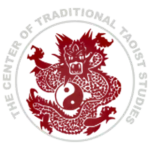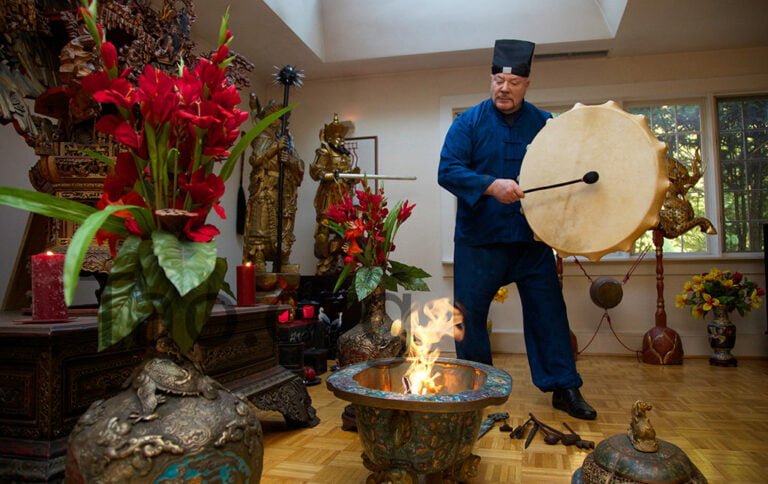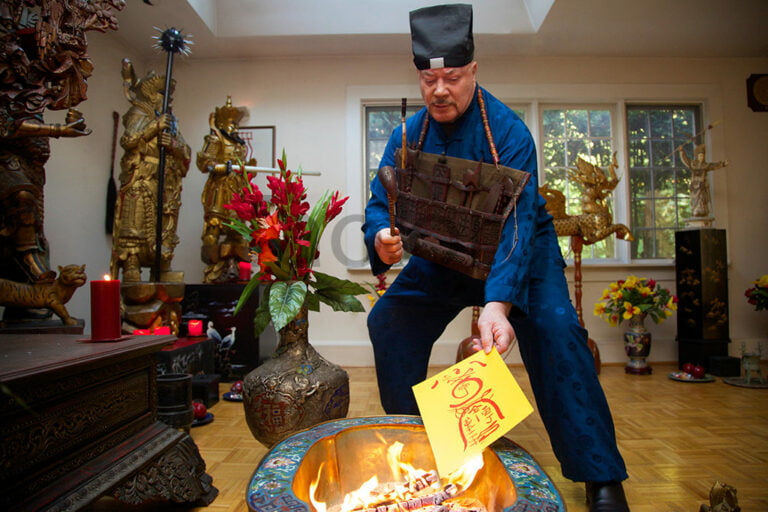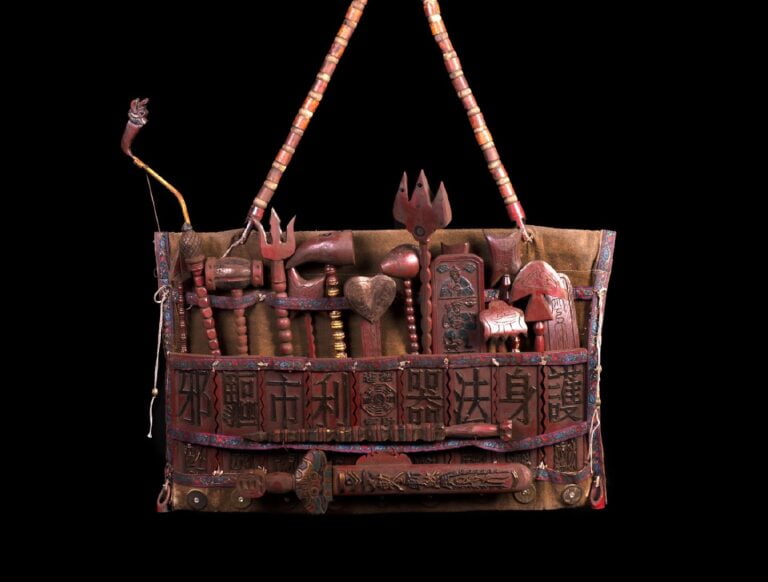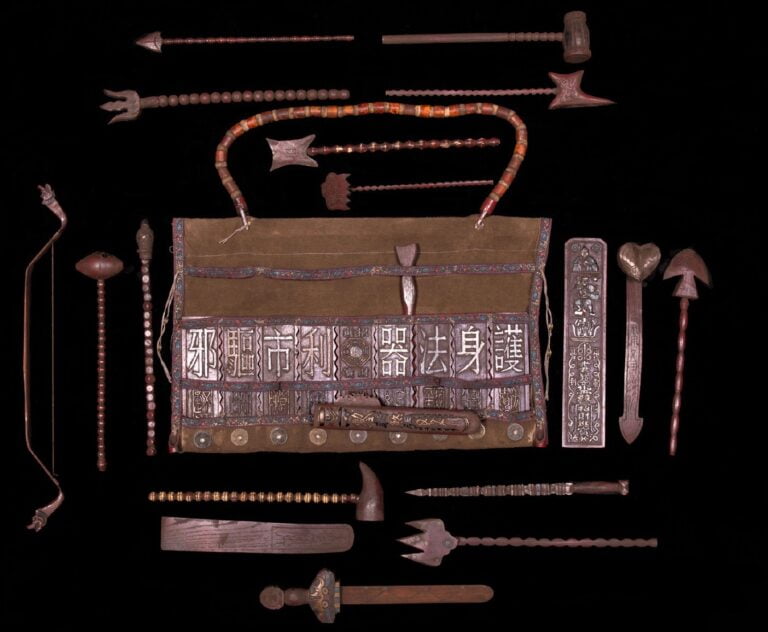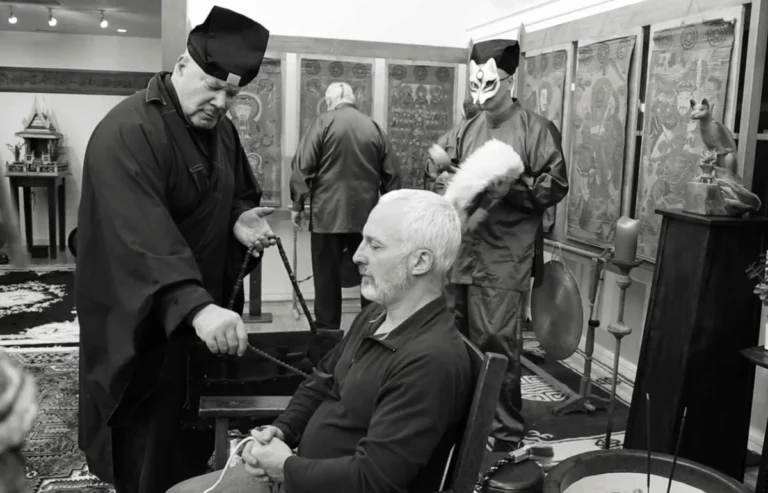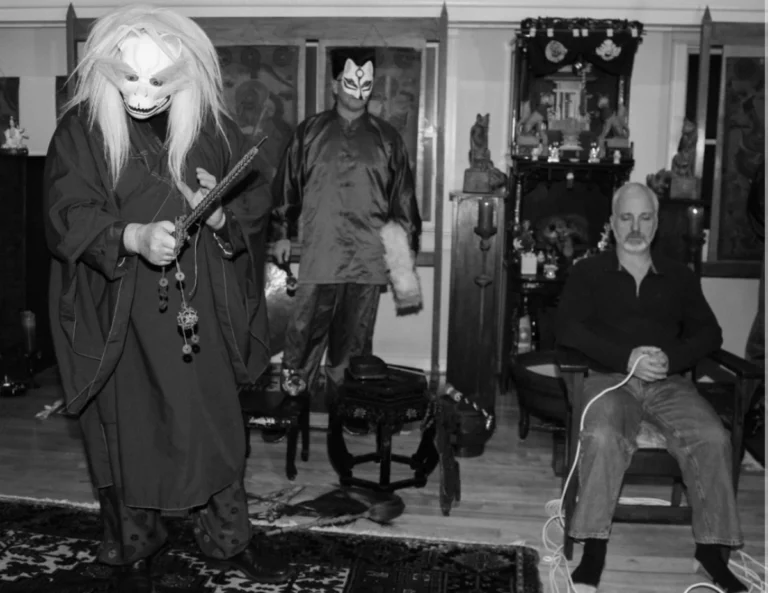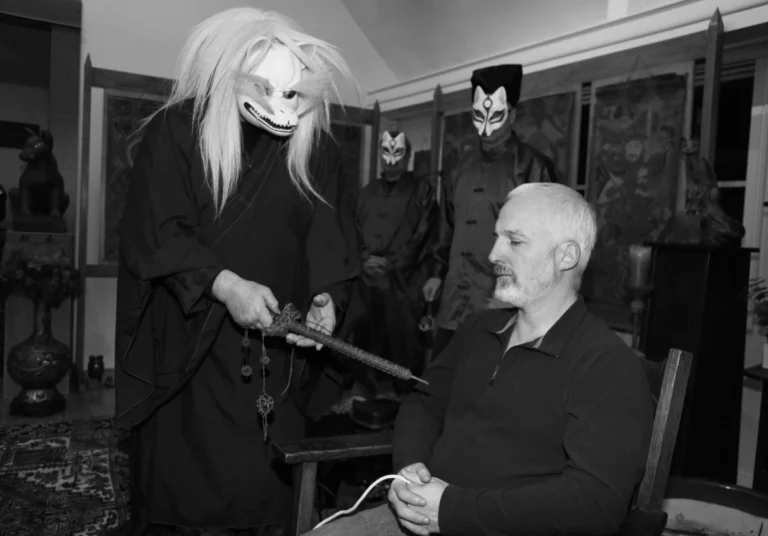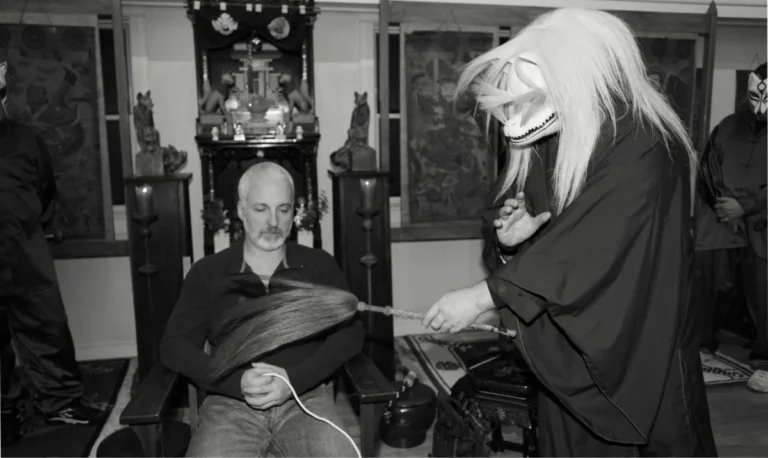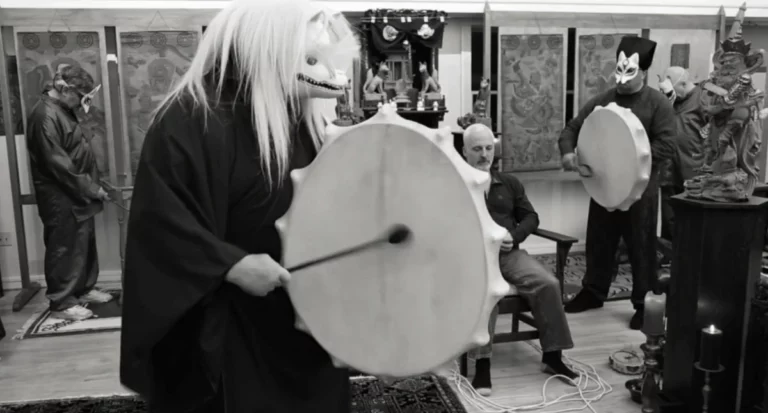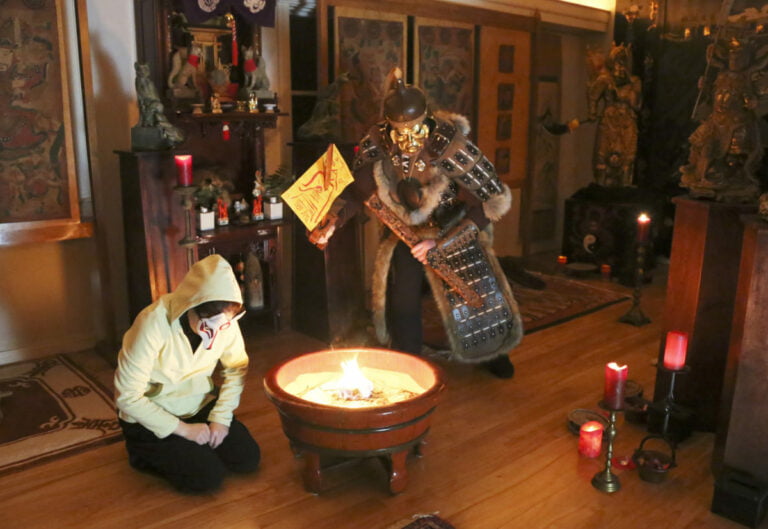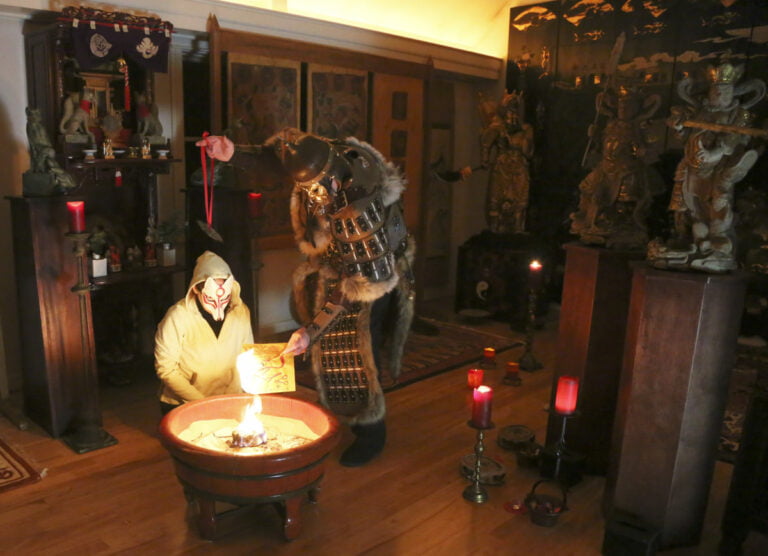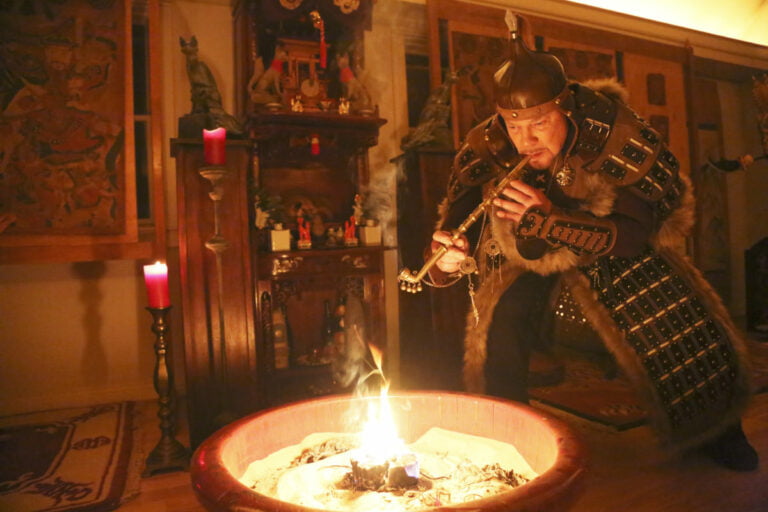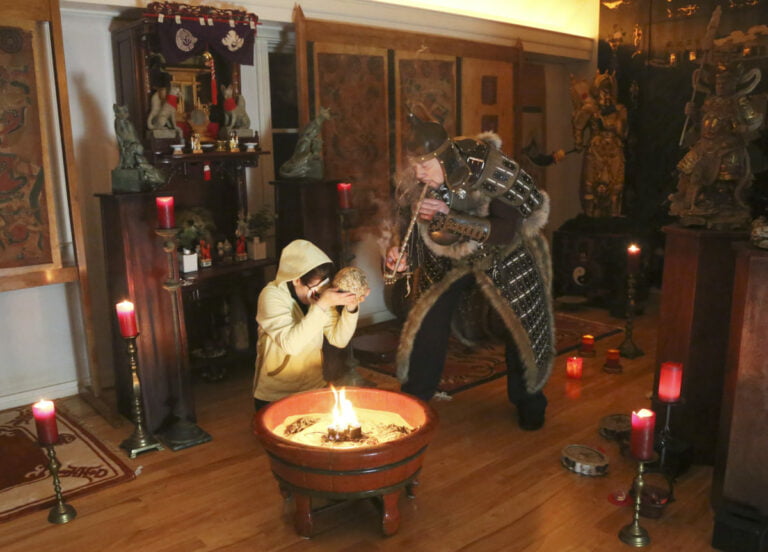Ancient Taoist Chinese Exorcism
Taoist Exorcism ceremony to ward off a malevolent spirit from the body of the afflicted man for physical health and wellness.
Taoist Lin Hun Therapy and Celestial Fox exorcism are based on the ancient theories of shamanism that espouse diseases, illnesses, and numerous medical conditions are the result of negative energies fostered by spiritual possession by malevolent entities. It is fascinating that almost every major world religion originally had a component of spiritual possession and exorcism.
According to Patrick McNamara (2011, 147) in Spirit Possession and Exorcism,
“Several of the world religions we know today had their origins in the so-called axial age that occurred roughly 2,500 years ago. … Buddhism, Confucianism, Daoism, the Hellenistic and Roman mystery religions, Christianity, the core prophetic aspects of Judaism and several other faiths as well. … [Islam arrived about a thousand years after the axial age and can be said to have completed it as it inherited many of the tenets and practices of the axial age religions.] Core aspects of each of these religious movements can be construed as attempts to reform improper use of spirit-possession techniques and thereby return to the old shamanistic attempts to control the techniques rather than be controlled by them.”
McNamara (2011, xi–xii) also argues,
“Humanity cannot be understood apart from religion and religion . . . cannot be understood apart from “spirit possession.” “Spirit possession” is the taking over of an individual’s sense of agency and identity by a supernatural agent. This “taking over” of the host’s sense of agency and identity can be either a positive or a negative experience. When it is positive, the mind and personality of the possessed individual are transfigured and the individual seems to be acting more freely and effectively … . In all cases of positive possession the new personality has left behind the old, the lower self, and now lives via a new transformed self linked to the divine consciousness and is in fact identified with this divine consciousness. The link to or bond with the divine consciousness seems to enhance perceptual capacities and intelligence and can produce some very fine character traits like gratitude, generosity, compassion for others, fearlessness, clear strategic sense, joy, and many other qualities besides. Clearly, any process that can enhance one’s perceptual and information processing capacities and give one these character traits must be transformative indeed and must be considered quite valuable—indeed priceless. …
The negative form of possession, however, was and is an experience of a very different kind, though once again perceptual and information-processing capacities of the possessed individual are often enhanced, though this time not permanently. Negative possession is now known in many cultures as “demonic possession.” In the ancient world negative forms of possession could occur with almost any sort of spirit entity, including many of the gods worshipped by the ancients as well as spirits of the dead, animal spirits, ancestor spirits, and all kinds of intermediate beings such as demi-gods, faeries, angels, mountain spirits, and many other types of beings as well. Although an individual undergoing demonic possession could often evidence unusual cognitive abilities like “reading the mind” of others, predicting future events, or having knowledge of foreign languages and the like, negative possession (I will call it “demonic possession”) was an experience that was feared. It has to be ranked among the most unfortunate and perilous forms of suffering a human being can undergo. It is so perilous a condition that special rituals have been evolved over the centuries by most peoples, at least all those who have been studied to date to rid the possessed of the demon or to prevent possession in the first place.”
The website myjewishlearning.com states that Judaism had a component of exorcism that has a documented ancient history.
“Key to any Jewish exorcism is having a truly pious man, an abba, baal shem, rebbe, or a rabbi, conduct the ceremony. … The process usually starts with the exorcist ritually purifying himself, either according to traditional Jewish practice, or by special means, such as anointing himself with water and oil. Some exorcists may invoke the presence of a maggid, or beneficent spirit, to assist them. Many exorcisms were public events, either performed in a synagogue, or at least requiring the presence of a minyan, a minimum of ten men that normally makes up a ritual quorum (Divrei Yosef). Various somatic symptoms (swellings, paralysis, markings, and bodily sensations) were sought in the victim for diagnostic purposes (Sha’ar ha-Gilgulim). Most techniques include interviewing the demon and/or dybbuk, taking a personal history, as it were, in order to understand what is motivating the spirit and so better effect the removal (Shalshelet Ira-Kabbalah). Many possessing spirits are evidently quite forthcoming and loquacious. At times cooperation was coerced from the demon by “fumigation,” exposing it to smoke and sulfur, a sympathetic invocation of the infernal realms (Igrot ha-Ramaz). The goal of the interview is to eventually learn the name of the evil spirit. The exorcist then uses the power of the demonic spirit’s own name to “overpower” it, by round after round of scripted ritual actions involving threats and rebukes, getting more intense and invasive with each effort. A few ceremonies on record reached the point of actually “beating” the demon out, but most simply involved verbal coercion. Jewish exorcisms are usually “liturgical,” using protective passages from the Psalms and other sacred texts.”
Christianity also had techniques of exorcism that called on Jesus as a sanctioning authority to command the malevolent offending spirits. It is described this way in An Encyclopedia of Religion (Ferm 1945, 268):
“Exorcism has likewise had an important place in higher religions, including Christianity. In order to demonstrate the power of Jesus over Satan the Synoptic Gospels depict him as exorcising demons, but through his own supernatural authority rather than by the invocation of God’s name and help. Christians, in both early and later periods, exorcised in the name of Jesus, less frequently in the name of God, claiming that the invocation of these holy names made their exorcism religious rather than magical. The rise of a minor order of exorcists in the church testifies to the wide currency of Christian exorcism. The present Catholic practice of prebaptismal exorcism, together with the exorcism of demoniacs and [the blessing] of objects like oil, water, and salt, originated in early times. Today, however, the priest alone is permitted to exorcise. The power attributed to the ‘name’ of Jesus survives in the customary conclusion to Christian prayers in which his name is invoked.”
According to the Handbook of Culture, Therapy, and Healing (Gielen et al. 2004, 350–351),
“Spirit possession and Exorcism is also known to have ancient roots in the religion and traditions of Islam where the offending spirits are known as jinn. In dealing with disorders caused by possession by the jinn, the treatment will aim at either exorcising the jinn or establishing symbiotic and working relationships with them. Exorcism (azima, literally incantation) is usually employed when the attack is by an unnamed jinn, whereas forming a symbiotic relationship is the aim of treatment when one is attacked by a named jinn. Although exorcism is a procedure practiced in almost all Arab-Muslim countries, specific treatments that aim at forming symbiotic relationships with the jinn are popular mainly in Egypt and North Africa and are usually carried out by specific cults. Exorcism also tends to be carried out in one session in contrast to the other treatments, which involve continuous sessions in which the patients become members of a cult and must go through the treatments periodically in order to placate the jinn, become their followers, and remain permanently dependent on them.
Although possession by the jinn is recognized in Islam, exorcism is not mentioned in the Qur’an. However, it seems to have been practiced in many Arab-Muslim communities. The exorcist (the mu’azzim) is not a specialist.
The methods of exorcism also vary from one healer to another. In Palestine, in carrying out exorcism, the Sheik massages the body, moving his hands from the upper part of the body downwards so that the devil is to leave the important areas (heart and lungs) and is eventually thrown out of the body through the lower extremities (e.g., toes). The massage turns in most cases into violent beatings. Currently, the Dervish follows similar procedures among the Negev Bedouins of Israel. Moreover, the Dervish employs music in exorcism in the belief that the jinn are attracted to it. Drums are used to convince the reluctant jinn to open a dialogue with the healer. The Dervish may also carry out exorcism during a dhikr ceremony. … The belief in North Africa that the jinn detest salt has resulted in its use to expel them. However, forcing the possessed patient to drink large amounts of salty water may sometimes result in death.”
Wikipedia states that exorcism was also central in classical Buddhism and Tibetan Buddhism.
“The practice of reciting or listening to the Paritta began very early in the history of Buddhism. It is a Buddhist practice of reciting certain verses and scriptures from Pali Canon in order to ward off misfortune or danger. The belief in the effective spiritual power to heal, or protect, of the Sacca-kiriyā, or asseveration of something quite true is an aspect of the work ascribed to the paritta.[2] Several scriptures in the Paritta like Metta Sutta, Dhajagga Sutta, or Ratana Sutta can be recited for exorcism purposes. …
The ritual of the Exorcising-Ghost day is part of Tibetan tradition. The Tibetan religious ceremony ‘Gutor’, literally offering of the 29th, is held on the 29th of the 12th Tibetan month, with its focus on driving out all negativity, including evil spirits and misfortunes of the past year, and starting the new year in a peaceful and auspicious way.
The temples and monasteries throughout Tibet hold grand religious dance ceremonies, with the largest at Potala Palace in Lhasa. Families clean their houses on this day, decorate the rooms and eat a special noodle soup called ‘Guthuk’. In the evening, the people carry torches, calling out the words of exorcism.”
Interestingly, most major religions like the celestial Fox Creed, Judaism, Christianity, Islam and Buddhism believe in a set of common fundamental religious principles involving spirit possession and exorcism. Exorcism is part of Traditional Chinese Medicine and has always been associated with human health and well-being. Mortal physical diseases have always related to a person’s confused and frustrated mental state. Exorcism helps to purge the malevolent influences that make people mentally and physically sick. A periodic platform of exorcism helps achieve healing and wellness. For generations, the techniques of exorcism have been used to help people who had difficulty functioning in the real world of society’s accepted norms and regulations. Today, the science of pharmacology and mind-altering medications is used to help the individual who has problems functioning in the world of everyday reality. The problem with drug therapy is that the powerful narcotics suppress the energies of the physical body, making the person feel mentally dull and physically tired. Conversely, as opposed to suppressing the physical body, exorcism frees the stagnation of energies in the body and helps promote healing and wellness. Exorcism helps cure mental and physical illness with the support and power of the celestial Creed of the Foxes.
What is the celestial Fox Creed?
The creed of the heavenly Foxes is possibly one of the oldest known religions, dating back to the third or fourth century B.C. Since it has historically been kept secret by its followers, it is practically unknown in Western civilization. This creed, laden with hidden symbolism, centers around spiritual deities known as Fox spirits that are part of the cultural and religious beliefs of both China and Japan. These beliefs spread throughout Southeast Asia, Mongolia, the Manchurian provinces, and what are today Buryatia and Kyrgyzstan. Currently, these geographic areas are actively involved in open worship of the holy Fox Creed. There are modern, functioning Fox temples in Thailand, Japan, Taiwan, and the United States.
In Thailand, legitimate images of nine-tail Fox deities are available and blessed by LP Nain, the master and abbot of Wat Kaset Ban Thung Setthi, a Buddhist temple in the Roi Ed province of Thailand. He is a master of heavenly Fox magic and is well known in Malaysia, Singapore, and China.
The main temple of Fushimi Inari in Kyoto, Japan, has many priests and miles of tori gates and holy Fox shrines on the main mountain retreat. In Japan, the celestial Fox Creed was naturally integrated with the Buddhist and Shinto religions, and it is one of the most prolific major Japanese religions, boasting thousands of public shrines across the country.
The beliefs of the creed of the venerable Foxes are also alive in Taipei, the political and financial center of Taiwan. It is noteworthy that the creed spread historically through political and cultural upheaval. The holy Fox religion traveled to Taiwan with Chiang Kai-Shek in 1949, when the Chinese nationalists were defeated and Chiang’s government was forced to move to the island, where he ruled for thirty years. Taiwan was entrusted to keep the ancient Chinese cultural and religious traditions alive and safe from the horrors of communism. As blog writer Jonathan Seidman (2010) described it in In Mystical Taiwan, “I was surprised to discover that there was a special temple devoted to worship of a celestial fox right here in Taipei City, the Hu-Xian Tang. I found the temple on the second floor of a building in downtown Taipei. On first entering, it didn’t seem a great deal different from most Taoist temples I’d seen. There was a shrine set into the far wall decked out in red and gold and on which lay a pot of incense. It was when I took a closer look at the statue of the goddess that I discovered the difference. The Goddess is shown as a beautiful woman dressed in ancient Chinese fashion, but upon looking more closely, one sees she has a tail.”
The Temple of Original Simplicity—headquartered in Boston, Massachusetts—has a modern working Hall of Celestial Foxes. The Hall and main altar are an integral part of the worship of the Celestial Foxes. Historically, most Taoist temples contained a Hall of Foxes, although shrines and altars were popular all over China. Sacred Taoist teachings state that the Celestial Fox deities can change the fate of an individual.
The Creed of Fox fairies holds a very special place in classical Taoist alchemy. Only Taoist alchemists and masters of celestial Fox fairies use magic diagrams. The use of magic diagrams is what separates Chinese Shamanism from other shamanistic rituals and procedures. Although the birth of the magic diagram is unknown just like the origin of the chart of acupuncture points, the practicality and result of both arts is obvious. Some principles of empirical metaphysics cannot be explained but can only be experienced.
The priest of the celestial Creed of Fox fairies uses magic Taoist diagrams to fight malevolent spirits with exorcism (purging) and preventative rituals for health and wellness. Plainly stated, the Taoist diagram is an ancient drawing, made with special inks, that defines a pattern capturing universal chi in a specific format to enable different outcomes in our physical dimension. These particular physical outcomes are a direct result of the gathering of universal cosmic energy in unique patterns. Although the same components are used as building blocks in many different diagrams, the individualized configuration of similar components create different physical outcomes. The formulaic patterns of cosmic chi, or diagrams, have been used for thousands of years by the Celestial Fox priest and Fox master to harness the celestial energies of the heavenly Fox deities for targeted practical purposes through prayer and meditation. There are specific magic Taoist exorcism diagrams that can capture malevolent entities inside the diagram itself, and when burned can send the evil spirit to the Court of the Jade Emperor (The King of all Taoist Gods) for judgement or retribution.
Heavenly Fox exorcism rituals—including Taoist Lin Hun Therapy and Taoist Divine Guidance, instantiate purifying celestial energy which can expel malevolent forces from the human soul, creating a positive aura bringing luck and contentment by changing misfortune to fortune. Under the unceasing Taoist principle of reversion, all of life’s phenomena grow, peak, and revert to their polar opposite, repeating the same cycle. In reality, the change associated with reversion can occur posthumously. Natural changes can take years to happen, and many times our ultimate demise signals the significant change. With the help of the venerable Fox deities, misfortune can change to fortune in the current invocation of our lives. Personal sincerity, Celestial Fox exorcism and Taoist Lin Hun Therapy can help the pendulum swing from misfortune to fortune in the great cycle of reversion to opposites by employing the heavenly power of the Fox deities in this dimension. Not only can these powerful gods protect us and make our earthly lives content, but they can bring us spiritual immortality in the afterlife. Connection and communication with the celestial Foxes can save the soul in this dimension and subsequently protect it in another.
